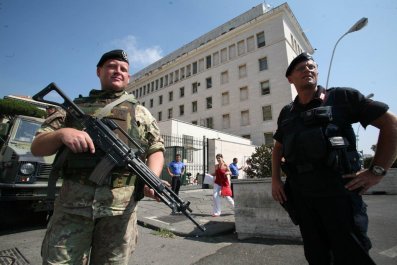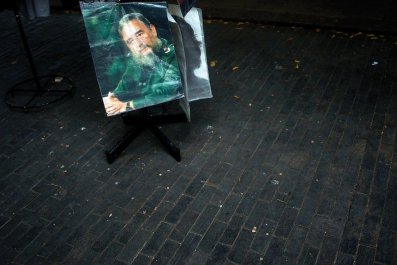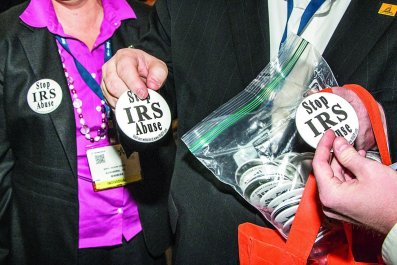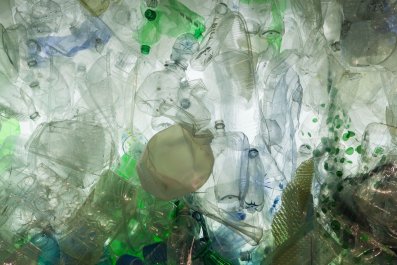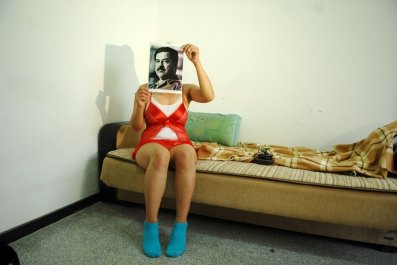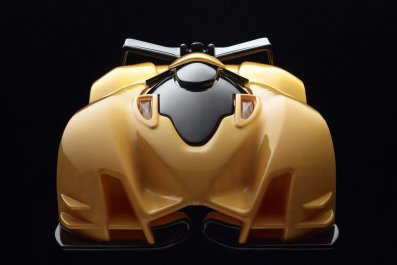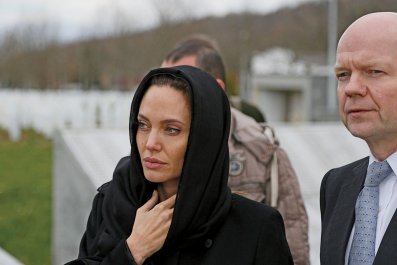In the second-floor stairwell of New York's Carlton Arms Hotel, a stylish young couple stares intently at the large cartoon figures before them. The woman's eyes dart from the round, blue thug grimacing behind prison bars to the spindly cowgirl howling atop a horse and clutching a bomb with a lit fuse. Her partner leans over and murmurs confidentially, "You know, this mural was painted by Banksy."
"No way!" The woman lingers a few more rapt moments, then turns to him and takes a swig of her beer. "Do you want to find the mime now?"
Such a question warrants only one answer, of course, and down the same hall, in a small room that still smells faintly of paint, they find a doe-eyed artist in a flimsy blue nightgown writhing silently to a baleful piano accompaniment, mimicking the impressionist nudes she had just brushed onto the walls. In the hallway outside, clusters of guests sip wine and snap photos of the jumbled illustrations that cover the walls—from wild slashes of color to muted, abstruse profiles. Another open doorway reveals a room painted floor to ceiling with realistic, multicolored garbage bags and a mannequin surrounded by food scraps. The building's resident cats weave around visitors' legs, yowling indignantly.
Such is the dizzying scene—or just one floor of it, rather—of the annual room-opening party at the Carlton Arms Hotel, one of New York's most remarkable and under-celebrated bohemian art enclaves. This evening in late March, the roughly 120-year-old boutique hotel on East 25th Street is celebrating the unveiling of five new rooms in its ongoing artist residency program, which invites up-and-coming international visual artists to live in the hotel for several months in exchange for redesigning a room.
Almost 200 artists have participated in the program since it began in the mid-'80s, producing as many unconventional chambers. Most rooms have been repainted numerous times; only a few of the originals exist. They run the gamut from beatific English cottage replications to drip-painted seascapes, enormous pop-art faces, photorealistic Japanese flora and postmodern moldings of faces and vines. Almost every surface of the four-floor, 54-room hotel boasts artistic flourishes, giving it an air of gritty, creative capriciousness—down to the tchotchke-strewn lobby, the ceilings pasted with Bubble Wrap and the windowsills lined with jagged piano keys.
"You see peeling paint in these rooms, and then another layer of peeling paint under that," Darek Solarski, a desk employee of the Carlton Arms, tells Newsweek. Originally from Poland, Solarski came to the hotel as an artist-in-residence 10 years ago and is now creating a trompe l'oeil ceiling painting in the main office. "We always say we could get a Guinness book world record for the longest art project running and how many artists have been involved."
"Some rooms are edgy, some are dark, others are kitschy. The quality of art varies as well, because we give a kind of carte blanche," adds Alex Wolkowicz, a hotel front-desk employee originally from Germany. She came to the hotel in 2012 as an artist, modernizing her room with stalactites of found glass. "For artists, it's a family-style environment, and people engage with your work on a level that I don't think you can have in a traditional gallery environment. You have someone surrounded by your work, sleeping. That's really intimate."
A rare beatnik holdout in New York's well-heeled Kips Bay neighborhood, its narrow red awning dwarfed by a long stretch of Baruch College towers, the Carlton Arms is not a widely known destination in the New York art scene. Still, the hotel has a venerable reputation internationally—especially in Europe, where multi-artist hotel residencies are more common—largely for its impressive creative alumni.
The residency program has yielded early, one-of-a-kind works from many artists who went on to achieve stardom, including the Spanish contemporary painter Paco Simon, the New York street art pioneer Richard Hambleton and, of course, the enigmatic graffiti magnate Banksy. The latter proved prolific during his residency in 1999, painting a room along with his prominent stairwell; its walls are an amusing cartoon tableau of anthropomorphized safari animals, the subjects not yet politicized but already suggesting weariness via a giraffe with a thought bubble that reads "R.I.P." (Carlton staffers gamely indulge Banksy's current, lucrative shroud of secrecy, disclosing only that he was quite reserved during his stay.)
{C}
"I'm still seeing rooms that I haven't been in yet," says Rob O'Connor, an artist resident from Tasmania; he designed the new "trash bag" room. "I like it because it's a bit rough around the edges. It's not sterile and slick like a Chelsea gallery. It's an artists' place."
Simon agrees. "My experience at the Carlton Arms changed my life. I met many amazing people who gave me a lot of inspiration; it is unlike anywhere else," said the artist, whose 1989 Mediterranean-inspired room of sun-washed hues and nude women still exists. "Every time I go to New York, I spend time there."
The building's mosaic history befits its interiors. Originally a turn-of-the-20th-century, working-class hotel, it became a speakeasy during Prohibition and a haven for drug addicts and prostitutes in the 1950s. In the 1960s, the hotel transitioned to a city-authorized single-room occupancy (SRO) structure that provided long-term shelter for welfare recipients.
"It was very volatile then—and at the same time, it was hilarious, disturbing, sad," says Eddie Ryan, who began managing the hotel in the early 1980s. He now lives in Costa Rica and operates the hotel La Costa de Papito. "These were lost souls."
The SRO system was discontinued a few years after Ryan's arrival. Dissatisfied with the building's dismal interiors, he invited his downtown artist friends to redesign the rooms; they flocked to these huge canvases, and the atmosphere brightened. New print advertisements cracked, "The Carlton Arms Hotel: This Ain't No Holiday Inn, and That's Not Chocolate on Your Pillow."
The artist residency program has operated ever since, usually in off-peak winter months. Rooms have minimal amenities with atypically low rates for Manhattan, beginning at $70 per night. Colorful characters abound; the place is "a crazy-people magnet," says John Ogren, a current manager. Eccentric artists and customers regularly assemble in the lobby to regale passersby with garrulous chatter and blithely further the rumors of ghosts upstairs.
Cassandra Guan, a program assistant for the independent study program at the Whitney Museum of American Art, notes there are other experimental residency programs in New York—prominently, the Queens studio complex Flux Factory—but the Carlton's primary function as a hotel makes its program unusual.
"Generally, artist residency programs are designed for artists to leave the city, not to come to it," Guan explains. "Urban artists residencies don't usually provide accommodations."
It is this atypical atmosphere, it seems, that breeds the Carlton's strong loyalty among its former artists.
"I loved to hang out while working. The program is an honest support system," raves James Zirco Fisher, who created the popular "Heart Chamber" scavenger hunt room in 2011. "It is a true portal between the New York of the turn of the 20th century and the New York of the future."
The Carlton Arms staff is currently perusing online submissions for future residencies. Its program's godfather hopes to return for an overdue visit this summer. And though the hotel is open year-round, it displays only the artists' rooms to the non-paying public on the open nights. The curious need to book a room and sleep in situ, as it were.
"The hotel is a monument," Ryan says proudly, "and when I come back to New York, I have a place to stay. That's the best part."




